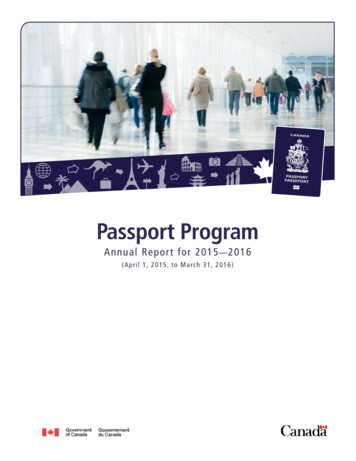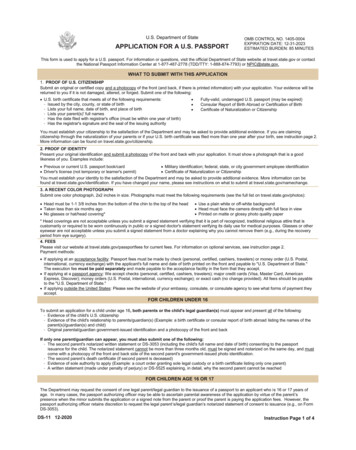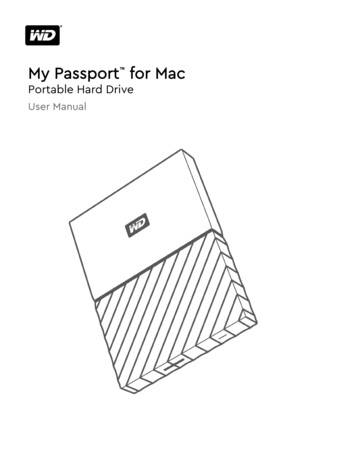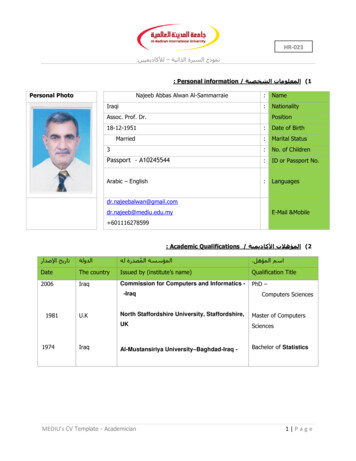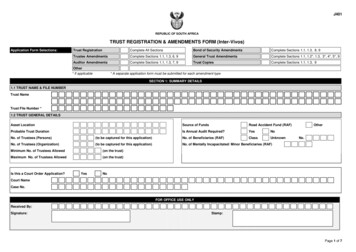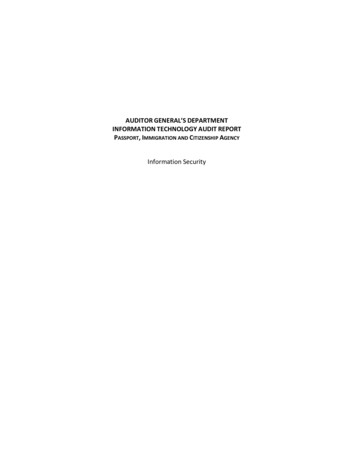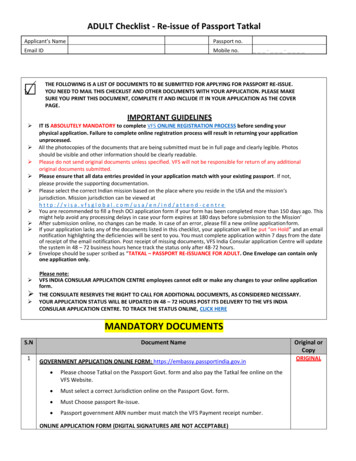
Transcription
PRIVACY IMPACT ASSESSMENTPassport Application Management System (PAMS) PIA1. Contact InformationA/GIS Deputy Assistant SecretaryBureau of AdministrationGlobal Information Services2. System Information(a) Name of system:(b) Bureau:Consular Affairs(c) System acronym:(d)Passport Application Management SystemPAMSiMatrix Asset ID Number:PAMS #120521 (MIS 724, PDITS 5227, PIERS 85,PLOTS 346, UMWS 4377)(e) Reason for performing PIA: Click here to enter text. New system Significant modification to an existing system To update existing PIA for a triennial security reauthorization(f) Explanation of modification (if applicable): Click here to enter text.3. General Information(a) Does the system have a completed and submitted Security Categorization Form (SCF)? Yes No - Contact IRM/IA at IASolutionCenter@state.gov for assistance.(b) What is the security Assessment and Authorization (A&A) status of the system?The system received an Extension of Authorization to Operate (ATO) on May 8, 2017. Theauthorization is valid until rescinded or the expiry date of July 31, 2019.(c) Describe the purpose of the system:PAMS is a logical business grouping of all passport applications for the Bureau of ConsularAffairs (CA), which consists of Management Information System (MIS), Passport DataInformation Transfer System (PDITS), Passport Information Electronic Records System(PIERS), Passport Lookout Tracking System (PLOTS), and User Manager Web Security(UMWS).MISThe Management Information System (MIS) is a web-based reporting tool that trackspredefined productivity statistics of U.S. passport agencies. It provides passport system
PAMSJune 2018management the ability to query the Travel Document Issuance System (TDIS) databases forinformation specific to any passport agency within the United States. This informationincludes weekly and monthly workloads, book inventory, agency hiring summaries, andstatistics regarding agency staff.PDITSThe Passport Data Information Transfer System (PDITS) is a consolidation of databasefunctionality and support under one design, development, and management structure. PDITSinterfaces with TDIS and Online Passport Status Service Structured Query Language (OPSSSQL). Prominent associations include being the recipient and repository of all issuedpassport data from TDIS. PDITS's mandate is to continually ensure data quality and integrityin the passport databases, particularly with respect to the data imported from TDIS.PIERSThe Passport Information Electronic Records System (PIERS) is a suite of web and desktopapplications that provide query and management capabilities for passport records, ConsularReports of Birth Abroad (CRBAs), Certificates of Witness to Marriage (CWM), Records ofDeath (ROD), Advance Finder (AF), Diplomatic and Official Tracking System (DOTS), andPanama Canal Zone (PCZ) data. It operates on the Department of State’s OpenNet network.(The OpenNet network is the Department of State’s internal network or intranet.) PIERSprovides direct access for OpenNet users at passport agencies, posts abroad, Department ofState directorates and offices and Record Services, and indirect access for external usersthrough the Consular Consolidated Database (CCD).The PIERS system provides users with both case-based and user-based views of informationand support for electronic checking and reporting of work processes. Case-based views referto the different types of data records that the PIERS system and database maintain. Thisincludes passport information (all records of issued and expired passports, not issuedapplications, and destroyed/ stolen/ lost passports) and consular records of overseas birthsand deaths. User-based views refer to the PIERS systems ability to provide access todifferent data elements, record types, and system functions based on specific groups orsystem application roles assigned to individual users.PLOTSThe Passport Lookout Tracking System (PLOTS) is a web enabled case management andimage archive system used to manage and adjudicate Consular Lookout Automated SupportSystem (CLASS) cases. The purpose of the PLOTS application is to provide CA domesticand post users with an efficient and reliable solution to the recording, managing, searchingand process streamlining of CLASS cases.UMWSPage 2
PAMSJune 2018User Manager Web Security is a web-based application used to manage user accounts. UserManager Web Security (UMWS) allows users to be assigned privileges to access Passportsystems to perform their tasks. User accounts for Bureau of Consular Affairs personnel whoare authorized to access the Passport Information Electronic Records System (PIERS),Management Information System (MIS), Passport Records Imaging System Management(PRISM), and Passport Lookout Tracking System (PLOTS) are created and assigned theappropriate privileges in UMWS. The user then can perform the tasks associated with theprivileges.(d) Describe the personally identifiable information (PII) that the system collects, uses,maintains, or disseminates:PAMS Names of Individuals Birthdates of Individuals Social Security Number or other Identifying Number Phone Number(s) of Individuals Business Addresses Personal Addresses Email Addresses of Individuals Images or Biometrics IdentifiersMISThe Passport Services Directorate of the Department of State (CA/PPT) uses the web-basedManagement Information System (MIS) to collect data and compile statistics related to thepassport processing activities of passport agencies. Departmental users collect data, compilestatistics and report on the following: passport production/ workload labor and staffing statistics passport employee productivity fees collected product inventory PLOTS case tracking PIERS privacy and user activityMIS retrieves the data from a variety of departmental databases and permits the user toschedule and run reports based on system privileges. MIS does not contain or report PII ofpassport requesters but merely permits departmental users to aggregate the statisticsregarding passports requested, issued/denied, due dates and similar information.PDITSPage 3
PAMSJune 2018PDITS receives the following PII as a data transfer from TDIS. TDIS obtains the informationfrom passport books and passport cards, applications for passport books and passport cards,amendments, extensions, replacements, and/or renewals of passport books or cards. Theinformation is not directly collected from the applicant. Although the DS 4085 is no longeraccepted for additional visa pages, the form is in the system and used for other purposes suchas miscellaneous actions, and collects the same PII. applicant's name date of birth place of birth gender Social Security number biometric IDs legal and family information mailing address email addressPIERSPIERS collects the following PII elements: name date of birth address telephone number Social Security number passport number driver’s license or other identifying number(s) education information financial transactions employer medical informationThe passport applicant provides the information via web-based PIERS. The PIERS data isinput into TDIS and transferred via the Front End Processor (FEP), which communicateswith PIERS to create new records and modify the records, and data share, which feeds data toPIERS. The data includes an approved passport application from the Post repository server,which is in place for the sole purpose of supplying OPSS with passport status data.PLOTSPLOTS collects and maintains records related to applications for U.S. passports and loss ofPage 4
PAMSJune 2018nationality. Sources of the information are U.S. citizens applying for passports, otherDepartment of State computer systems, passport specialists, and fraud prevention managers.The record subjects in PLOTS are past and current applicants for a U.S. passport who may besuspected of having felony warrants, suspected of committing passport fraud, owe debts todependents, be indebted to the federal government for a repatriation or other loan, or may bedenied a passport or be issued only a restricted passport for certain other reasons permissibleby statute and/or regulation.Components of an individual's record (called a "case") in PLOTS are of two kinds. The firstkind is the passport application and all supporting documentation related to it, includingcitizenship evidence, correspondence, reports of investigation, passport specialists' diaryentries, court orders, passport revocation actions, and passport denial actions. (For a detaileddescription of PII in passport applications, please see the TDIS PIA.) The passportapplication and supporting documents are imported into PLOTS electronically by way ofseparate Consular Affairs passport processing systems, not directly from the applicant.The second kind of information in PLOTS about an individual is one or more "lookouts."Lookouts serve to alert passport specialists of possible fraud or other irregularities related toa person having the same or similar name and date of birth as that of the applicant. Lookoutsare created by passport specialists at passport agencies/centers and at overseas posts inPLOTS which are then entered into the Consular Lookout and Support System (CLASS).UMWSUMWS collects last name, first name, login ID, office location, office phone number, officeemail address of federal employees who access applications in PAMS.(e) What are the specific legal authorities and/or agreements that allow the information to becollected? 8 U.S.C. 1401-1504 (Title III of the Immigration and Nationality Act of 1952, asamended) 18 U.S.C. 911, 1001, 1541-1546 (Crimes and Criminal Procedure) 22 U.S.C. 211a-218, 2705 (Passports and Consular Reports of Birth Abroad) 22 U.S.C 2651a (Organization of Department of State) Executive Order 11295, of August 5, 1966, 31 FR 10603 (Authority of the Secretary ofState in granting and issuing U.S. passports) 8 U.S.C. 1104 (Powers and Duties of the Secretary of State) 8 U.S.C. 1185 (Travel Documentation of Aliens and Citizens) 22 C.F.R. Parts 50 and 51 (Nationality Procedures and Passports) 26 U.S.C. 6039E (Information Concerning Resident Status) 22 U.S.C. § 2714a.(f) (Revocation or Denial of Passport in Case of Individual withoutSocial Security Number)Page 5
PAMSJune 2018(f) Is the information searchable by a personal identifier (e.g., name or Social Security number)? Yes, provide:- SORN Name and Number:STATE-26 - Passport Records, March 24, 2015STATE-05 - Overseas Citizens Records, September 8, 2016 No, explain how the information is retrieved without a personal identifier.(g) Does the existing SORN need to be amended to reflect the inclusion of this new orsignificantly modified system? Yes NoIf yes, please notify the Privacy Division at Privacy@state.gov.(h) Is there a records retention schedule submitted to or approved by the National Archives andRecords Administration (NARA) for this system? Yes No(If uncertain about this question, please contact the Department’s Records Officer atrecords@state.gov .)If yes provide:- Schedule number, Length of time the information is retained in the system, and Type ofinformation retained in the system:A-13-001-02 Passport Books: Recovered, Surrendered, Unclaimed or FoundDescription: These passports books were issued to individuals who have returned themon their own initiative or at the request of the Department of State or other Governmentagency or have been found, recovered, and/or forwarded to Passport Services(PPT/TO/RS). They include Diplomatic or other official passports issued to militarypersonnel who are either discharged, retired or deceased during the validity period of thepassport; No Fee passports issued to Peace Corps volunteers; tourist passports; and allother passports.Disposition: Destroy after receipt has been logged into PIERS database or successorelectronic database. (ref. N1-059-96-5, item 2)DispAuthNo: N1-059-04-2, item 2A-13-001-16 Passport Lookout MasterDescription: This on line information system assists Passport Services staff indetermining those individuals to whom a passport should be issued or denied, identifiesthose individuals who have been denied passports, or those who are not entitled to theissuance of full validity passport and those whose existing files must be reviewed priorto issuance.Disposition: Destroy when active agency use ceases. (ref. N1-059-96-5, item 16)DispAuthNo: N1-059-04-2, item 16A-13-002-02 Requests for PassportsPage 6
PAMSJune 2018Description: Copies of documents relating to selected passport requests.Disposition: Temporary: Cut off at end of calendar year. Hold in current file area andretire to Records Service Center when 2 years old. Destroy/delete when twenty-five (25)years old.DispAuthNo: N1-059-05-11, item 2A-13-002-03 Tracking/Issuance SystemDescription: Electronic database used for maintenance and control of selected duplicatepassport information/documentationDisposition:Permanent: Delete when twenty-five (25) years old.DispAuthNo: N1-059-05-11, item 34. Characterization of the Information(a) What entities below are the original sources of the information in the system? Please checkall that apply. Members of the Public U.S. Government employees/Contractor employees Other (people who are not U.S. Citizens or LPRs)(b) If the system contains Social Security Numbers (SSNs), is the collection necessary? Yes No- If yes, under what authorization?26 U.S.C. 6039E (Information Concerning Resident Status) and22 U.S.C. § 2714a. (f) (Revocation or Denial of Passport in Case of Individual without SocialSecurity Number)(c) How is the information collected?The passport information is collected when an applicant fills out an application for a passportand/or passport card or other passport services offered. The following forms apply:Department of State Form (DS 11) – Application for a U.S. Passport (First-time applicants,all minors, and applicants who are not eligible to use the DS 82)Department of State Form (DS 82) – U.S. Passport Renewal Application for EligibleIndividuals (by mail)Department of State Form (DS 5504) – Application for a U.S. Passport (Corrections, NameChange within 1 year of Passport issuanceDepartment of State Form (DS 64) – Statement Regarding Lost or Stolen PassportDepartment of State Form (DS 3053) – Statement of Consent – Issuance of a Passport to aMinor Under Age 16Department of State Form (DS 5525) – Statement of Exigent/Special Family Circumstances– For Issuance of a Passport to a Minor Under Age 16Department of State Form (DS 86) – Statement of Non-Receipt of a U.S. PassportPage 7
PAMSJune 2018(d) Where is the information housed? Department-owned equipment FEDRAMP-certified cloud Other Federal agency equipment or cloud Other- If you did not select “Department-owned equipment,” please specify.(e) What process is used to determine if the information is accurate?The accuracy of the information is checked against sources including but not limited to,Social Security Administration, Law Enforcement, and Internal Revenue Service.(f) Is the information current? If so, what steps or procedures are taken to ensure it remainscurrent?Passport applicants are responsible for providing current information on their passportapplications. Passport applicants can modify or amend records by accessing the websitewhere the record was established or by contacting the relevant departmental office.Information can also be updated during the adjudication process.Information in PAMS is updated when an applicant submits a passport application. Theinformation is only as current as the last update to the data specific to PAMS and PAMScomponents.(g) Does the system use information from commercial sources? Is the information publiclyavailable?The system does not get information from commercial sources nor is it publicly available.(h) Is notice provided to the individual prior to the collection of his or her information?Yes, a passport applicant is advised of all the relevant privacy implications at the time theindividual completes and signs the application via a Privacy Act Statement. The applicant isnotified of the following: His/her PII is being collected The purpose for which it is required The possible uses of the information The possibility that the data may be shared with other organizations/ agencies How the data is protected from unauthorized/ illicit disclosure Potential consequences if the applicant declines to provide the data (e.g. that his/herpassport application may be declined).Completing, signing and submitting a passport application serves as legal consent from theindividual to authorize the U.S. government to utilize his/her information for specificpurposes, to include adjudicating his/her passport application, and under certaincircumstances to revoke the passport in accordance with U.S. law.Page 8
PAMSJune 2018(i) Do individuals have the opportunity to decline to provide the information or to consent toparticular uses of the information? Yes No- If yes, how do individuals grant consent?At the time applicants complete the passport application, they are notified of their optionto decline to provide the required information, and they are advised that to do so maycause their passport application to be denied. Passport applicants are also notified of therelevant privacy implications of providing their information, and how their informationmay be used and shared with other agencies. Passport applicants are not given the optionto selectively consent to or deny specific uses of the information. The passport applicantgrants complete consent upon signing the application. The applicant’s signature providesthe authorization to the U.S. government to use and share the information.- If no, why are individuals not allowed to provide consent?(j) How did privacy concerns influence the determination of what information would becollected by the system?The Department of State understands the need for PII to be protected. Accordingly, the PII inPAMS is handled in accordance with federal privacy regulations regarding the collection,access, disclosure, and storage of PII. PAMS only collects the information necessary for theprocessing of passport applications.5. Use of information(a) What is/are the intended use(s) for the information?PAMS is a logical business grouping of all passport applications for CA, which consists ofManagement Information System (MIS), Passport Data Information Transfer System(PDITS), Passport Information Electronic Records System (PIERS), Passport LookoutTracking System (PLOTS) and User Manager Web Security (UMWS).MISPassport Agencies and the Department of State headquarters use the MIS system, a webbased application, to collect data on: Passport production – the production data is submitted both weekly and monthly Labor & Staffing – the staffing data is submitted weeklyPDITSPDITS receives PII (passport books and passport cards, applications for passport books andpassport cards, amendments, extensions, replacements, and/or renewals of passport books orcards) from TDIS to electronically verify and validate PII. This information is shared withPage 9
PAMSJune 2018the Department of Homeland Security/Customs and Border Protection (DHS/CBP) tovalidate and authorize admissions and exits of persons in the U.S.PIERSThe PIERS system provides its users with both case-based and user-based views ofinformation, and support for electronic checking and reporting of work processes. Casebased views of information are used to manage and track record access cases for issuedpassports, providing information such as reasons for adjudication decisions for use inprocessing passports. Such information includes all records of issued and expired passports,not issued applications, destroyed/stolen/lost passports and consular records of overseasbirths. User-based views of information assist the PIERS system in determining access todifferent data elements, record types, and system functions based on specific groups orsystem application roles assigned to individual users.PLOTSPLOTS is used by the Bureau of Consular Affairs Directorate of Passport Services, otherConsular Affairs offices, and the Bureau of Diplomatic Security. Information contained inPLOTS allows these users to manage and track a passport lookout case. Lookouts arecreated by passport specialists at passport agencies/centers and at overseas posts in PLOTS.Lookouts data alerts passport specialists of possible fraud or other irregularities related to aperson having the same or similar name and date of birth as that of the applicant. PLOTSinformation assists in determining a potential denial of a passport, initiation of a criminalinvestigation, fraud and fraud prevention, a child in the Children’s Passport Alert Program orissues related to verifying the applicant’s citizenship or identity.UMWSThe information in User Manager Web Security (UMWS) is used to assign access to Passportsystems. User accounts for Bureau of Consular Affairs personnel who are authorized toaccess the Passport Information Electronic Records System (PIERS), ManagementInformation System (MIS), Passport Records Imaging System Management (PRISM), andPassport Lookout Tracking System (PLOTS) are created and assigned the appropriateprivileges in UMWS. The user then can perform the tasks associated with the privileges.(b) Is the use of the information relevant to the purpose for which the system was designed or forwhich it is being designed?Yes, the information relates to passport issues and management of the passport applicationprocess.(c) Does the system analyze the information stored in it? Yes NoIf yes:Page 10
PAMSJune 2018(1)(2)(3)(4)What types of methods are used to analyze the information?Does the analysis result in new information?Will the new information be placed in the individual’s record? Yes NoWith the new information, will the Department be able to make new determinationsabout the individual that would not have been possible without it? Yes No6. Sharing of Information(a) With whom will the information be shared internally and/or externally? Please identify therecipients of the information.The information is shared internally within the Bureau of Consular Affairs to includePassport agencies and the Passport Services Directorate, and with the Bureau of DiplomaticSecurity. Information is not directly shared with any external organizations.PLOTS with Diplomatic Security.PIERS information is indirectly shared with DHS via the Consular Consolidated Database(CCD). Queries are made via the CCD and provided to DHS.PDITS shares information with the Department of Homeland Security. The Consular DataInformation Transfer System (CDITS) queries PDITS and provides information to thePassport DHS Senior Agency Official for Privacy (SAOP).(b) What information will be shared?Information about passport applicants, status of applications, all records of issued andexpired passports, not issued applications, and destroyed/stolen/lost passports.(c) What is the purpose for sharing the information?The information is shared to assist the Department of State in managing and tracking thepassport application process.Sharing of information externally is a means to verify data and to acquire information on anypossible issues regarding applicants for adjudication. Information shared with DHS is tovalidate and authorize admissions and exits of persons in the U.S,(d) The information to be shared is transmitted or disclosed by what methods?All information is shared using Department of State approved Information SystemConnection Ports, Protocols and Services.Internal Information Sharing:Internal information is shared by direct secured communications (data-base to database)using transport and message level security interfaces with other Consular systems and U.S.mail.Page 11
PAMSJune 2018PLOTS information is shared internally with Diplomatic Security by utilizing the StateDepartment secure internal network. Information is shared by secure transmission ofsensitive but unclassified information in accordance with the Department of State policy forhandling and transmission of sensitive but unclassified information.External Information Sharing:PIERS Information shared externally with DHS is through CCD, utilizing secure transportlayer security methods permitted under Department of State policy for handling andtransmission of sensitive but unclassified information.PDITS information shared through CDITS with the DHS, utilizes secure transport layersecurity methods permitted under Department of State policy for handling and transmissionof sensitive but unclassified information.(e) What safeguards are in place for each internal or external sharing arrangement?Internal recipients, within the Department of State, must comply with U.S. governmentrequirements for the protection and use of PII. These safeguards include but are not limited tosecurity training and internal Department policy for the handling and transmission of“Sensitive but Unclassified” information. In addition, all Department users are required toattend annual privacy and security awareness training to reinforce safe handling practices.Data shared with other government agencies (DHS) is carefully regulated according toMemorandums of Agreement/ or Understanding (MOA/U) formally signed by AuthorizingOfficials of the agency.(f) What privacy concerns were identified regarding the sharing of the information? How werethese concerns addressed?Privacy concerns regarding the sharing of information focus on two primary sources of risk:1) accidental disclosure of information to non-authorized parties, or 2) deliberate disclosure/theft of information regardless of whether the motivation was monetary, personal or other.Accidental disclosure is usually due to inadequate document control (hard copy orelectronic), inadequate PII and security training, or insufficient knowledge of roles,authorization and need-to-know policies. In addition, social engineering, phishing, andfirewall breaches can also represent a risk of accidental disclosure of information.The Department of State mitigates these risks by enforcing rules and requirements regarding: Frequent, regular security training for all personnel regarding information security,including the safe handling and storage of PII, “Sensitive But Unclassified,” and allhigher levels of classification;Page 12
PAMSJune 2018 Strict access control based on roles and responsibilities, authorization and need-toknow;Implementation of management, operational, and technical controls regardingseparation of duties, least privilege, auditing, and personnel account management.7. Redress and Notification(a) What procedures allow individuals to gain access to their information?The system contains Privacy Act-covered records; therefore, notification and redress are theright of record subjects. Procedures for notification and redress are published in the Systemof Records Notice (SORN) Passport Records - STATE-26, and in rules published within 22CFR Part 171.(b) Are procedures in place to allow an individual to correct inaccurate or erroneousinformation? Yes NoIf yes, explain the procedures.Individuals who wish to obtain their records or have them amended must submit a writtenrequest to the U.S. Department of State, Office of Law Enforcement Liaison Division(CA/PPT/S/L/LE) at the address cited in the Passport Records SORN, STATE-26, posted onthe Department of State Privacy website.If no, explain why not.(c) By what means are individuals notified of the procedures to correct their information?Individuals who wish to have their records amended can find instructions, submissionrequirements, and the address of the U.S. Department of State, Office of Law EnforcementLiaison Division (CA/PPT/S/L/LE) in the Passport Records SORN, STATE-26, posted onthe Department of State’s Privacy website, www.state.gov/privacy.8. Security Controls(a) How is the information in the system secured?The PAMS system is secured within the Department of State intranet where risk factors aremitigated through the use of multiple layers of security controls, including managementsecurity, auditing, firewalls, and physical security.(b) Describe the procedures established to limit access to only those individuals who have an“official” need to access the information in their work capacity.As a matter of policy, the Department of State Chief Information Officer and InformationSystem Security Officer require certain fundamental procedures for all systems. PotentialPage 13
PAMSJune 2018users are screened and assigned privileges based on their roles, responsibilities and the needto-know. Specific privileges for a given user are only granted after careful consideration ofthe user role. There are three types of PAMS user roles: System/Web Administrators,Application Administrators and Database Administrators. All access is enforced by userprofiles according to the principle of least privilege and the concept of separation of duties.(c) What monitoring, recording, and auditing safeguards are in place to prevent the misuse of theinformation?Various technical controls are in place to deter, detect, and defend against the misuse ofpersonally identifiable information. Monitoring occurs from the moment an authorized userattempts to authenticate to the Department of State OpenNet and respective applications.From that point on any changes (authorized or not) that occur to data in the PAMSapplications are recorded. In accordance with Department of State Security ConfigurationGuides, auditing is enabled to track the following events on the host operating systems, andback-end database servers: Multiple logon failures;Logons after-hours or at unusual times;Failed attempts to execute programs or access files;Addition, deletion, or modification of user or program access privileges; orChanges in file access restrictions.Th
Affairs (CA), which consists of Management Information System (MIS), Passport Data Information Transfer System (PDITS), Passport Information Electronic Records System (PIERS), Passport Lookout Tracking System (PLOTS), and User Manager Web Security (UMWS). MIS The Management Information System (MIS) is a web-based reporting tool that tracks
